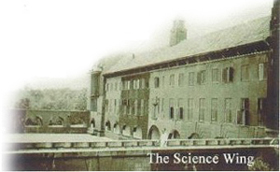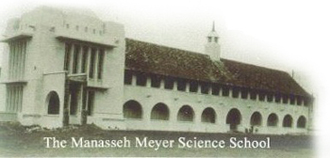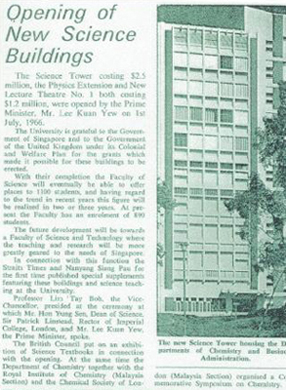The Raffles College Period
1929 – 1948

The Department of Chemistry started as part of the Raffles College in 1929. Chemistry classes was taught initially in the Government Analyst’s offices at Sepoy Lines. The first lecture on chemistry in the College was delivered by Dr G. E. Brooke. Dr George McOwan, who arrived in 1929, became the first Professor of Chemistry. He was later joined by Mr C. T. J. Owen in 1930 as a lecturer in the department. Dr P. Purdie succeeded Prof G. McOwan as the Professor of Chemistry in 1940 when the latter resigned.
Raffles College reopened in 1946 after World War II. Dr M. Jamieson and Dr A. Jackson of the Government’s Department of Chemistry assumed the positions of Professor and lecturer, respectively, in the Department.
The University of Malaya Period
1949 – 1962

In 1949, the University of Malaya was formed via the amalgamation of Raffles College and King Edward VII College of Medicine, for which the Department of Chemistry was subsumed under. Prof R. A. Robinson was instrumental in the rapid expansion and development of the department. He was assisted by Mr Kiang Ai Kim as lecturer and Mr Lim Chin Kuan as Assistant Lecturer.
Staff strength increased steadily with the appointment of numerous lecturers over this period: Dr Leong Peng Cheong (1950), Mr M. C. K. Svasti (1950), Dr Rayson R. L. Huang (1951), Mr R. W. Green (1951), Dr E. N. A. Sullivan (1954), Dr Ang Kok Peng (1955), Mr Francis Morsingh (1956) and Dr Lee Hiok Huang (1959). In 1959, Prof Robinson resigned and was succeeded by Dr R. L. Huang was the acting Head of Department. Prof Robinson was later conferred the title of Emeritus Professor of Chemistry in recognition of his service. Prof Kiang Ai Kim formally took over the Head of Department in 1960.

During the Raffles College era, the Department of Chemistry was housed in the right wing of the Manasseh Meyer Science Building at the Bukit Timah campus. With the rapid increase in enrolment in the early 1950s, the Department expanded into the upper left wing of the Manasseh Building and half of the FMS Building in 1953. It also occupied the lower left wing of the Manasseh Building in 1959 which housed the newly established microanalytical laboratory.
The Nanyang University period
1956 – 1979
The Department of Chemistry was one of the major departments in Nanyang University when it was inaugurated in 1956. In the earlier years, practically all teaching staff were recruited from either Hong Kong or Taiwan. The return of several alumni, who completed their higher degrees in USA, filled gaps in staff positions. They Dr Aw Beng Teck, Dr Chew Chwee Har, Dr Gan Leong Ming, Dr Goh Suat Hong, Dr Koh Lip Lin, Dr Khoo Swe Hoo, Dr Lee Hee Khiam, Dr Lee Swee Yong, Dr Mok Chup Yew, Dr Ng Ang Ser, Dr Wong Ming Keong. The Department headship was rotated between Dr Koh Lip Lin, Dr Lee Swee Yong and Dr Gan Leong Ming until 1975 when the department was merged as part of the National University of Singapore with Prof Kiang Ai Kim assuming headship.
By 1977, the Department at Nanyang University occupied almost the whole ground floor of the main buildings of the College of Science, with seven laboratories for undergraduate teaching and one glass-blowing workshop. These laboratories were already well-equipped with specialized instrumentations including NMR, IR and UV/Vis spectrophotometers and X-ray diffractometers.
The University of Singapore period
1962 – 1979

The University of Malaya in Kuala Lumpur was established in 1959, and in 1962 the branch in Singapore was renamed the University of Singapore. Vacancies in staff positions were filled by local returning scholars who had recently graduated with PhD degrees from British universities. These included Dr Huang Hsing Hua, Dr Tan Eng Liang (the first local Rhodes Scholar) and Dr Sim Keng Yeow.

Prof F. H. C. Kelly, the first Professor of Applied Chemistry, was appointed in 1968 to take charge of the Applied Chemistry section of the Department.
In April 1975 the Applied Chemistry section formally became the Department of Chemical Engineering within the Science Faculty. It was not until 1980 that this new Department was transferred to the Faculty of Engineering.
During this period, the Department also witnessed a steady increase in staff numbers with almost one new appointment per year from mid-1960 to the beginning of the 1970s. The new staff included Dr Yeo Ning Hong who joined in 1971 and later became a key cabinet Minister in the Singapore’s government. Prof Kiang Ai Kim retired in 1971 and was conferred Emeritus Professorship. He was succeeded by Assoc Prof Ang Kok Peng who had just returned to the Department after his stint as Singapore’s ambassador to Japan (1967-1971). Shortly after assuming the headship, he was appointed as the Minister of State for Communications and later the Minister of State for Health. During his absence from 1972 to 1975, Assoc Prof Lee Hiok Huang, who rejoined the Department from the University of Malaya, assumed Head of Department.
The total number of chemistry students was also increasing rapidly. A new building, the Science Tower, was allocated to the Department. This ten-storey building, reputed to be the tallest university structure in Asia at that time, was officially opened by Mr Lee Kuan Yew, Prime Minister of Singapore on Friday, 1 July 1966. With a total floor area of about 6500 sqm, it had rooms and laboratories for 20 academic staff, teaching laboratories, student research laboratories, microanalytical laboratory, glass blower’s room, chemical stores and workshop.
Joint Campus Period
1979 – 1980

This brief period was a prelude to the eventual merger of the University of Singapore and the Nanyang University into a single university.
The National University of Singapore Period
1980 – Present

Nanyang University was merged with the University of Singapore to form the National University of Singapore in 1980. The Faculty of Science was moved to Kent Ridge to its current location in June 1981. This began a period of rapid growth and transformation for both for the University and the Department of Chemistry. New staff members, both academic and non-academic, now numbering about a hundred, were recruited to meet the increasing student population.
Prof Ang Kok Peng served as the Head of Department until he retired in 1988. After his demise in 1997 and the Ang Kok Peng Memorial Fund was established in honour of his stellar service to the Department. This fund is used to support educational programmes and activities for the development of chemistry in Singapore.
<!–
Since 1988, Assoc Prof Sim Keng Yeow, Prof Lee Soo Ying, Assoc Prof Lai Yee Hing, Prof Lee Hian Kee, Prof Andy Hor, Prof Xu Guo Qin and Prof Loh Kian Ping have taken up the headship mantle. The current Head of Department is Prof Richard Wong Ming Wah, who took over the reins since Aug 2016.
–>
In parallel with the rapid increase in students and staff numbers, as well as the evolution of chemistry technology and research, the Department is increasingly focusing its attention towards avenues that would promote excellence both in teaching and research. Between 1980-94, an Industrial Chemistry course (Chemistry B) was introduced to final year students to meet the increasing demand from industry for our graduates with an applied chemistry background. The introduction of the Direct Honours programme was yet another innovation to cater to exceptional students so that they could their Honours degree in three years under an accelerated programme.
In 1994, all departments in the Faculty switched to the modular system to permit students to proceed at a pace compatible with their needs and abilities. All courses and laboratories in the Department were thus reorganised into categories of core, elective and enrichment modules. In 2012, the Department began to offer Specialisation in Material Chemistry, Medicinal Chemistry and Energy & Environment, to enhance the students’ interests in these disciplines that are deemed to be important for continued Singapore’s economic success. In 2014, the Department restructured the undergraduate curriculum so that the first 2 years are devoted mainly to develop their foundation knowledge in chemistry, while the ensuing 2 years would be focussed on developing their expertise in emerging and niche chemistry areas. In 2015, the Department rolled out a graduate education programme which included its flagship PhD degree as well as a new MSc by coursework degree in Energy and Environment.
NUS launched the new College of Humanities and Sciences (CHS) in December 2020 which brought together the deep expertise of the Faculty of Arts & Social Sciences (FASS) and the Faculty of Science (FOS) to deliver an interdisciplinary education to students. The College admitted its inaugural cohort in Academic Year 2021/2022. Align with the College’s direction, the Department revamped its undergraduate curriculum to offer Chemistry as first major, Chemistry as first major with specialisation in Chemical Research, Chemistry as second major, minor in Chemistry, minor in Analytical Chemistry, and minor in Nanoscience (together with physics). The new M.Sc. in Chemical Sciences coursework programme was launched in Academic Year 2021/2022 to replace the MSc by coursework degree in Energy and Environment.
